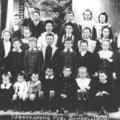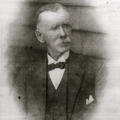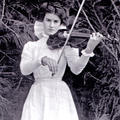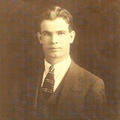McGee, Francis
Born in 1866 at Conjola on the south coast of NSW, Frank McGee's teaching career started at Goulburn in 1881, aged15. Stints at Milton, Croobyar and Robertson were followed by Yarralumla (Bulgar Creek) 1890-98 and Tuggeranong 1898-1927.
Boarding with the local Morrison family whilst teacher at Bulgar Creek, he married their daughter Mary in 1893. They subsequently had seven children.
In February 1898 he was teaching half time at Nerrabundah ('Long Gully') and Bulga Creek schools until November, when he was sent to Tuggeranong. In February 1907 Frank taught half time at Tharwa until April 1908 when he was again full time at Tuggeranong.
During his nearly thirty years at this school he instigated many physical changes, including a kitchen block added in 1899 and a new roof in 1912, when he took twelve months leave. Heritage listed because of Frank's career, and that of his son, James, Tuggeranong School still stands – now in the suburb of Chisholm.
Frank brought a solid education to generations of families in the remote Tuggeranong Valley. Well respected by the local community, Frank actively involved himself and his family in religious, sporting and musical events until he retired in 1927, back to the south coast. He died in 1950 and is buried in Conjola General Cemetery.
The following account is an extract from Les Lyons, The Morrisons of 'Bulga Creek' and 'Tralee', Canberra Historical Journal, 1974.
The eldest daughter Mary Anne Morrison was born on 12 June 1864. She married Francis J. McGee, formerly of Conjola, in 1891 when he was in charge of the Bulga Creek School. They lived in a cottage not far from the school until his transfer to the Tuggeranong Public School. There were seven children of the marriage - the first four were born at Bulga Creek and the other three at Tuggeranong. When Mr McGee retired in 1927, the people of Tuggeranong and district presented him with an illuminated address which stressed his public service including his long period of teaching (36 years) during which he had striven to build up the character of his pupils. His activities in sport and Church affairs were spoken of in glowing terms and he was referred to as the father of cricket at Tuggeranong'.
In thanking the people, Mr McGee said his reward for his long years of teaching was to see the sterling fellows around him who had been his pupils. He felt some pride that he had helped to train some good citizens and worthy Australians. He had always endeavoured to inculcate principles making for character, independence and respectfulness; much of the success of his school work had been due to his pupils' upbringing in their first school – their homes. Mrs McGee's kindness and neighbourly spirit were commended by the several speakers who referred to her as a second mother in the district, especially times of sickness.
Mr McGee returned to Conjola and, with the aid of his eldest son, worked a small property. He is buried at Conjola whilst his wife, who died at the Lane Cove home of her daughter Mary Lowry on 12 September, 1944 is buried at the Field of Cemetery, Sydney.
In addition to other activities, Mr McGee will be remembered for his efforts in introducing orderly beekeeping at Bulga Creek and Tuggeranong and in encouraging Irish dancing, three of his children – Michael, Mary (who married George Lowry of the staff of the War Historian, Dr C.W.E. Bean) and Him (now Professor J. D.McGee), were apt. pupils of Mr Joe Spillane of Goulburn. Michael taught three of the 'Tralee' Morrison children – Margaret, Ted and Clare – to do Irish jigs and reels. Easter Monday Sports at the original 'Tralee' property would have been less entertaining had items from these gifted dancers and the accompanying tunes played on the violin by Uncle Frank been missing from the programme.
The planting of trees was another of his hobbies. He organized arbor days at Bulga Creek School and seeds from trees planted there were given to Mr T.C.G. Weston for propagation at the Canberra Nursery. The resulting plants are said to have formed part of the pine plantation at Mt Stromlo that was burnt in the disastrous fire of 1952.
Two of the older McGee children – Phil and Kathleen – have gone to their
reward. Phil was a member of the firm of Wallace & McGee of Dubbo which during World War II constructed many large buildings at military camps in the Central West of New South Wales. Kathleen married a schoolmaster – Fred Cleaver, a member of a well-known Canberra family.
Michael McGee, the third son, followed in his father's footsteps in becoming a Public School teacher and acquiring an interest in trees. He retired a few years ago from the Headmastership of the High Elementary School at Albury. Their family of 10 children include two priests in the Wagga Diocese, and a teaching sister in the Mercy Order. Son Pat McGee entered the building trade.
Another son, Emeritus Professor James D. McGee, has won distinction as a physicist of international renown especially in the field of television and astro-physics and at the time of his retirement was Professor of Applied Physics at the Royal College of Science, London. His academic attainments are set out in 'Who's Who' and give some idea of the breadth of his scholastic interests, his ultimate distinction being his election to Fellowship of the Royal Society in 1966. In his earlier years, Jim was no mean violinist.
Biodata
Born: 8 July 1866. Milton, NSW
Married: Mary Anne Morrison 11 January 1893
Died: 13 Feb 1950. Conjola, NSW
Buried: Conjola Cemetery NSW
Harry Oldfield remembers Mr McGee
Former pupil at Tuggeranong, Harry Oldfield, born in 1912, was interviewed by Margaret Park in November 2006 when Harry was ninety four. Harry spoke fondly of his school years, although he was sceptical about how much he learned at the time...it was his teacher, Mr Francis McGee who left him with many lasting memories and words of wisdom.
When I asked Harry to describe Mr McGee, he responded as if he saw him only yesterday -
'Well, the main thing, he used to smoke a pipe, and if you did something bad and was kept in after school, well, you always knew where to find him. You'd go around and sniff a bit and you could smell the smoke, and there McGee would be. He was a lovely man...He was very thin - very thin - and grey haired...not very tall...very scholastic looking; and that's how he was.
He was very quiet; everyone loved him except the time when he kept you in occasionally, just to show you he was boss.'
[Recorded for the ACT National Trust, this interview was made possible through an ACT Heritage Grant].
Frank McGee – poet
Apart from being a skilled teacher, it appears he was also a creative writer and poet. When interviewed, Harry Oldfield related stories about Mr McGee, and his recollections revealed this piece composed by Mr McGee about 'Bob the Postman'. Harry's rendition didn't miss a beat!
An extract from 'Old Bob the Mailman' by 'Tugg' (Frank McGee):
Six days a week on Tharwa Road
Our mailman you can see
His name you ask: We'll call him Bob
Just Bob for brevity......
But still he packs the schoolboys up
And somehow jams them in
With bread and meat and other things
Like sardines in a tin.......
[published in the Queanbeyan Age, 14 December 1922]
Related Photos
Schools
- Yarralumla ('Bulgar Creek')
01/1890 - 11/1898 - Nerrabunda ('Long Gully') School
02/1898 - 11/1898 - Tuggeranong School
11/1898 - 04/1927 - Tharwa School
Half Time, 02/1907 - 04/1908






